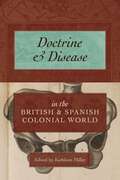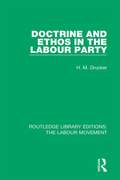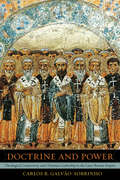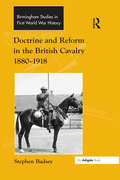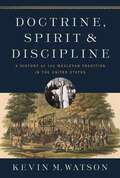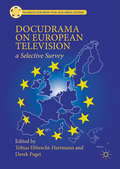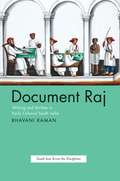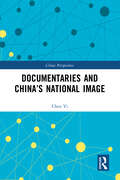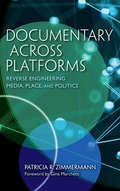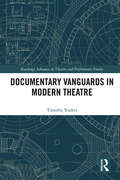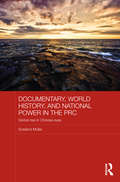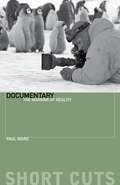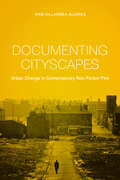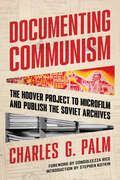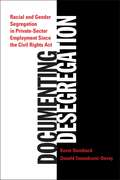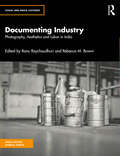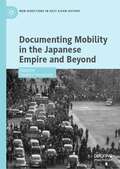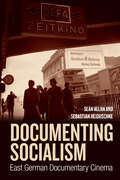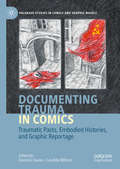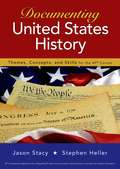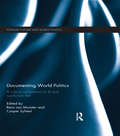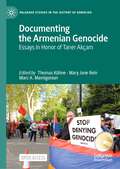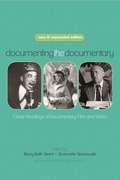- Table View
- List View
Doctrine and Disease in the British and Spanish Colonial World
by Kathleen MillerDuring the early modern period, unprecedented migration caused diseases to take hold in new locales, turning illness and the human body into battlegrounds for competing religious beliefs as well as the colonial agendas in which they were often ensnared. This interdisciplinary volume follows the contours of illness, epidemics, and cures in the early modern British and Spanish Empires as these were understood in religious terms.Each chapter of this volume centers on a key moment during this period of remarkable upheaval, including Jesuit co-optation of Indigenous knowledge in Peru, the Catholic Church’s dissemination of the smallpox vaccine across the Spanish Empire, Puritan collective fasting during smallpox outbreaks, and the practice of eating dirt as Obeah resistance among enslaved people in Jamaica. Throughout, the contributors explore how the porous geographical borders of the transatlantic world meant that medicine and religion were translated through and against each other, over and over again. Residing at the nexus between two largely discrete areas of inquiry, this collection provides significant insight into the numerous points of juncture between medicine and religion in the Atlantic world.In addition to the editor, the contributors to this volume include Matthew James Crawford, Crawford Gribben, Rana A. Hogarth, Philippa Koch, Allyson M. Poska, Catherine Reedy, and Rebecca Totaro.
Doctrine and Ethos in the Labour Party (Routledge Library Editions: The Labour Movement #12)
by H. M. DruckerFirst published in 1979. In this important study of Labour Party ideology, the author sought to provoke his readers to a fundamental re-evaluation of the party and of the relationships between the party, Labour ideology and socialist doctrine. What he had to say would have disturbed left and right wings alike within the party, while remaining accessible to students and general readers at all levels who have an interest in the considered analysis of British politics and the concept of ideology.
Doctrine and Power: Theological Controversy and Christian Leadership in the Later Roman Empire (Transformation of the Classical Heritage #51)
by Carlos R. Galvão-SobrinhoDuring the fourth century AD, theological controversy divided Christian communities throughout the Eastern half of the Roman Empire. Not only was the truth about God at stake, but also the authority of church leaders, whose legitimacy depended on their claims to represent that truth. In this book, Galvao-Sobrinho argues that out of these disputes was born a new style of church leadership, one in which the power of the episcopal office was greatly increased. The author shows how these disputes compelled church leaders repeatedly to assert their orthodoxy and legitimacy--tasks that required them to mobilize their congregations and engage in action that continuously projected their power in the public arena. These developments were largely the work of prelates of the first half of the fourth century, but the style of command they inaugurated became the basis for a dynamic model of ecclesiastical leadership found throughout late antiquity.
Doctrine and Reform in the British Cavalry 1880–1918 (Routledge Studies in First World War History)
by Stephen BadseyA prevalent view among historians is that both horsed cavalry and the cavalry charge became obviously obsolete in the second half of the nineteenth century in the face of increased infantry and artillery firepower, and that officers of the cavalry clung to both for reasons of prestige and stupidity. It is this view, commonly held but rarely supported by sustained research, that this book challenges. It shows that the achievements of British and Empire cavalry in the First World War, although controversial, are sufficient to contradict the argument that belief in the cavalry was evidence of military incompetence. It offers a case study of how in reality a practical military doctrine for the cavalry was developed and modified over several decades, influenced by wider defence plans and spending, by the experience of combat, by Army politics, and by the rivalries of senior officers. Debate as to how the cavalry was to adjust its tactics in the face of increased infantry and artillery firepower began in the mid nineteenth century, when the increasing size of armies meant a greater need for mobile troops. The cavalry problem was how to deal with a gap in the evolution of warfare between the mass armies of the later nineteenth century and the motorised firepower of the mid twentieth century, an issue that is closely connected with the origins of the deadlock on the Western Front. Tracing this debate, this book shows how, despite serious attempts to ’learn from history’, both European-style wars and colonial wars produced ambiguous or disputed evidence as to the future of cavalry, and doctrine was largely a matter of what appeared practical at the time.
Doctrine, Spirit, and Discipline: A History of the Wesleyan Tradition in the United States
by Kevin M. WatsonThe definitive history of the Wesleyan movement in the United States.An expansive, substantive history of the Wesleyan tradition in the United States, Doctrine, Spirit, and Discipline offers a broad survey of the Methodist movement as it developed and spread throughout America, from the colonial era to the present day.It also provides an theological appraisal of these developments in light of John Wesley's foundational vision. Beginning with Wesley himself, Watson describes the distinctiveness of the tradition at the outset. Then, as history unfolds, he identifies the common set of beliefs and practices which have unified a diverse group of people across the centuries, providing them a common identity through a number of divisions and mergers.In the midst of the sweeping changes happening in Methodism and the pan-Wesleyan movement today, Watson shows that the heart of the Wesleyan theological tradition is both more expansive and substantive than any singular denominational identity."A fresh, panoramic overview of the history of the Methodist movement. . . Promises to be a standard textbook on the history of Methodism for years to come." —TIMOTHY C. TENNENT, Asbury Theological Seminary
Docudrama on European Television
by Tobias Ebbrecht-Hartmann Derek PagetThis book explores docudrama as a creative response to troubled times. With generic characteristics formed via traditions in theatre as well as film, and with claims to fact underscored by investigative journalism, television docudrama examines key events and personalities in unfolding national histories. Post-Fall of the Berlin Wall, docudrama has become a means for nations to work through traumatic experiences both within national borders and Europe-wide. In this regard, it is an important genre for television networks as they attempt to make sense of complex current events. These authors offer a template for further study and point towards ways in which European television cultures, beyond those discussed here, might be considered in the future.
Document Raj: Writing and Scribes in Early Colonial South India
by Bhavani RamanHistorians of British colonial rule in India have noted both the place of military might and the imposition of new cultural categories in the making of Empire, but Bhavani Raman, in "Document Raj," uncovers a lesser-known story of power: the power of bureaucracy. Drawing on extensive archival research in the files of the East India CompanyOCOs administrative offices in Madras, she tells the story of a bureaucracy gone awry in a fever of documentation practices that grew ever more abstractOCoand the power, both economic and cultural, this created. aIn order to assert its legitimacy and value within the British Empire, the East India Company was diligent about record keeping. Raman shows, however, that the sheer volume of their document production allowed colonial managers to subtly but substantively manipulate records for their own ends, increasingly drawing the real and the recorded further apart. While this administrative sleight of hand increased the companyOCOs reach and power within the Empire, it also bolstered profoundly new orientations to language, writing, memory, and pedagogy for the officers and Indian subordinates involved. Immersed in a subterranean world of delinquent scribes, translators, village accountants, and entrepreneurial fixers, "Document Raj" maps the shifting boundaries of the legible and illegible, the legal and illegitimate, that would usher India into the modern world.
Documentaries and China’s National Image (China Perspectives)
by Chen YiEmphasizing the role of documentary in shaping a nation-state’s image, demonstrating social development and promoting cultural exchanges, this book examines the changes in China’s national image in documentaries at home and abroad since 1949. Based on theoretical frameworks of media sociology, political economy of communication and cultural studies, the book traces the development of Chinese documentary and discusses social transformation and cultural representation embodied in documentaries related to China. It is revealed how these works witness, reflect and interact with social transitions in all aspects of a modernizing China, as well as how documentary production struggles among and mediates between technology, market, ideology, social forces and professionalism. In terms of future prospects of documentary in an era when media convergence is burgeoning, the author explores feasible paths to further promotion of cross-cultural communication and China’s national image, by analyzing documentary aesthetics and representative cases of documentary practice. The title will appeal to scholars and students interested in culture and communication, documentary, film, media and Chinese society.
Documentary Across Platforms: Reverse Engineering Media, Place, and Politics
by Patricia R. ZimmermannIn Documentary Across Platforms, noted scholar of film and experimental media Patricia R. Zimmermann offers a glimpse into the ever-evolving constellation of practices known as "documentary" and the way in which they investigate, engage with, and interrogate the world. Collected here for the first time are her celebrated essays and speculations about documentary, experimental, and new media published outside of traditional scholarly venues. These essays envision documentary as a complex ecology composed of different technologies, sets of practices, and specific relationships to communities, engagement, politics, and social struggles. Through the lens of reverse engineering—the concept that ideas just like objects can be disassembled to learn how they work and then rebuilt into something new and better—Zimmermann explores how numerous small-scale documentary works present strategies of intervention into existing power structures. Adaptive to their context, modular, and unfixed, the documentary practices she explores exploit both sophisticated high-end professional and consumer-grade amateur technologies, moving through different political terrains, different platforms, and different exhibition contexts. Together these essays demonstrate documentary’s role as a conceptual practice to think through how the world is organized and to imagine ways that it might be reorganized with actions, communities, and ideas.
Documentary Culture and the Laity in the Early Middle Ages
by Warren C. Brown Marios Costambeys Matthew Innes Adam J. KostoMany more documents survive from the early Middle Ages than from the Roman Empire. Although ecclesiastical archives may account for the dramatic increase in the number of surviving documents, this new investigation reveals the scale and spread of documentary culture beyond the Church. The contributors explore the nature of the surviving documentation without preconceptions to show that we cannot infer changing documentary practices from patterns of survival. Throughout Late Antiquity and the early Middle Ages - from North Africa, Egypt, Italy, Francia and Spain to Anglo-Saxon England - people at all social levels, whether laity or clergy, landowners or tenants, farmers or royal functionaries, needed, used and kept documents. The story of documentary culture in the early medieval world emerges not as one of its capture by the Church, but rather of a response adopted by those who needed documents, as they reacted to a changing legal, social and institutional landscape.
Documentary Vanguards in Modern Theatre (Routledge Advances in Theatre & Performance Studies)
by Timothy YoukerPractitioners and critics alike often attribute great authenticity to documentary theatre, casting it as a salutary alternative not only to corporate news outlets and official histories but also to the supposed "self-indulgence" and "elitism" of avant-garde theatre. Documentary Vanguards in Modern Theatre, by contrast, argues for treating documentarians as vanguardists who (for good or ill) push, remap, or transgress the margins of historical and political visibility, often taking issue with professional discourses that claim a monopoly on authoritative representations of the real. This is the first book to situate documentary theatre’s development within the larger story of theatrical experimentalism, collage art, collective ritual, and other avant-garde dramaturgical and performance practices of the late 19th and 20th Centuries.
Documentary, World History, and National Power in the PRC: Global Rise in Chinese Eyes (Chinese Worlds)
by Gotelind MuellerDocumentaries have recently become a favourite format for Chinese state-directed media to present an officially sanctioned view of history. Indeed, this is not confined to Chinese national history. In stark contrast to the earlier self-centred preoccupation with Chinese history, there has been an upsurge in interest in foreign history, with a view to illuminating China’s role not only in world history, but also on the global stage today, and in the future. This book examines three recent Chinese documentary television series which present the officially sanctioned view of the rise of the modern West, the reasons for the end of the Soviet Union, and the legitimisation of the present-day Chinese government via a specific reading of modern Chinese history to argue for a ‘Chinese rise’ in the future. With a focus on these documentaries, Gotelind Müller discusses how history is presented on screen, and explores the function of visual history for memory culture and wider society. Further, this book reveals how the presentation of Chinese and foreign history in a global framework impacts on the officially transmitted views on Self and Other, and thus provides a keen insight into how the Chinese themselves regard their ‘global rise’. Documentary, World History, and National Power in the PRC will be welcomed by students and scholars working across a number of fields, including Chinese studies, East Asian studies, media studies, television studies, history and memory studies.
Documentary: The Margins of Reality (Short Cuts)
by Paul WardIn using case studies such as Touching the Void (2003) and the films of Nick Broomfield, this timely introduction to the growing field of documentary explores the definition and understanding of the form, as well as the relationship between documentary and drama, specifically the notion of reconstruction and reenactment. Paul Ward also discusses animated documentaries, the fertile genre of comedy, and feature-length contemporary works that have achieved widespread cinematic release.
Documenting Cityscapes: Urban Change in Contemporary Non-Fiction Film (Nonfictions)
by Iván Villarmea ÁlvarezWhile film studies has traditionally treated the presence of the city in film as an urban text operating inside of a cinematic one, this approach has recently evolved into the study of cinema as a technology of place. From this perspective, Documenting Cityscapes explores the way the city has been depicted by nonfiction filmmakers since the late 1970s, paying particular attention to three aesthetic tendencies: documentary landscaping, urban self-portraits, and metafilmic strategies. Through the formal analysis of fifteen works from six different countries, this volume investigates how the rise of subjectivity has helped to develop a kind of gaze that is closer to citizens than to the institutions and corporations responsible for recent major transformations. Documenting Cityscapes therefore reveals the extent to which cinema has become an agent of urban change, in which certain films not only challenge the most controversial policies of late capitalism but also are able to produce spatiality themselves.
Documenting Communism: The Hoover Project to Microfilm and Publish the Soviet Archives
by Stephen Kotkin Charles G. PalmIn late 1991, the Soviet Union was officially dissolved. Over the next 12 years, the Hoover Institution microfilmed and published the newly opened records of the Soviet Communist Party and the Soviet State. Among the 10 million pages were records of the central organs of the Communist Party; the NKVD, which regulated the ordinary lives of the Russian people; the GULAG, the secret police department that ran the forced labor camps; and the 1992 trial of the Communist Party.Charles Palm, who led this mission, details how he and his colleagues secured a historic agreement with the Russian Federation, then launched and successfully carried out the joint project with the Russian State Archives and their partner, Chadwyck-Healey Ltd. The success of the project hinged on managing logistics among the three partners across three continents, facing down critics in Russia and elsewhere, and navigating the unstable political terrain that prevailed in Russia during the 1990s. The Hoover Institution's decisive action during a brief window of opportunity preserved on microfilm and provided worldwide access to the records of Soviet Communism and helped bring to account one of the most consequential ideologies of the 20th century.
Documenting Desegregation: Racial and Gender Segregation in Private Sector Employment Since The Civil Rights Act
by Kevin Stainback Donald Tomaskovic-DeveyEnacted nearly fifty years ago, the Civil Rights Act codified a new vision for American society by formally ending segregation and banning race and gender discrimination in the workplace. But how much change did the legislation actually produce? As employers responded to the law, did new and more subtle forms of inequality emerge in the workplace? In an insightful analysis that combines history with a rigorous empirical analysis of newly available data, Documenting Desegregation offers the most comprehensive account to date of what has happened to equal opportunity in America--and what needs to be done in order to achieve a truly integrated workforce. Weaving strands of history, cognitive psychology, and demography, Documenting Desgregation provides a compelling exploration of the ways legislation can affect employer behavior and produce change. Authors Kevin Stainback and Donald Tomaskovic-Devey use a remarkable historical record--data from more than six million workplaces collected by the U. S. Equal Employment Opportunity Commission (EEOC) since 1966--to present a sobering portrait of race and gender in the American workplace. Progress has been decidedly uneven: black men, black women, and white women have prospered in firms that rely on educational credentials when hiring, though white women have advanced more quickly. And white men have hardly fallen behind--they now hold more managerial positions than they did in 1964. The authors argue that the Civil Rights Act's equal opportunity clauses have been most effective when accompanied by social movements demanding changes. EEOC data show that African American men made rapid gains in the 1960s at the height of the Civil Rights movement. Similarly, white women gained access to more professional and managerial jobs in the 1970s as regulators and policymakers began to enact and enforce gender discrimination laws. By the 1980s, however, racial desegregation had stalled, reflecting the dimmed status of the Civil Rights agenda. Racial and gender employment segregation remain high today, and, alarmingly, many firms, particularly in high-wage industries, seem to be moving in the wrong direction and have shown signs of resegregating since the 1980s. To counter this worrying trend, the authors propose new methods to increase diversity by changing industry norms, holding human resources managers to account, and exerting renewed government pressure on large corporations to make equal employment opportunity a national priority. At a time of high unemployment and rising inequality, Documenting Desegregation provides an incisive re-examination of America's tortured pursuit of equal employment opportunity. This important new book will be an indispensable guide for those seeking to understand where America stands in fulfilling its promise of a workplace free from discrimination.
Documenting First Wave Feminisms
by Maureen Moynagh Nancy ForestellContemporary feminists are used to juggling many different identities at once, balancing affiliations based on race, nation, class, and sexuality. First-wave feminists also negotiated--or failed to negotiate--similar tensions in their international organizing. Using primary documents dating from the abolitionist movement to the Second World War, Maureen Moynagh and Nancy Forestell investigate the tensions inherent in organizing early transnational feminist movements.Documenting First Wave Feminisms: Volume 1 provides a historical framework to bring together voices of women both canonical and less well known, from Mary Wollstonecraft to Mabel Dove, who were active in feminist movements in all corners of the world. Suffrage, imperialism, citizenship, sexuality, and moral reform are shown to be key issues in a variety of exchanges across North America, Europe, the global south, and the Pan-Pacific region. This source book is as nuanced as first-wave feminism itself and will prove a valuable resource for studying women's rights in an increasingly globalized world.
Documenting Industry: Photography, Aesthetics and Labor in India (Visual and Media Histories)
by Rebecca M. Brown Ranu RoychoudhuriWhether a smoky portrait of a coal mine or a sweeping shot of workers building an immense dam, photographs of established and emerging industries fundamentally shaped the visual culture and politics of South Asia in the decades after independence. This volume engages with the image of the laboring body against monumental machines, dams, and infrastructure and the ways in which photography engages with strands of modernist aesthetics to support new modes of seeing the changing industrial landscape and the human body.The multidisciplinary essays in the book embrace the porosity of “documentary” and “journalistic” photography and draw out questions of aesthetics in relation to both modernizing calls to industry and modernist framings of the visual in India. The book looks back at photographs from the twentieth and twenty-first centuries and critically considers post-World War II industry—with its imagery of factories belching pollutants into the air and the reality of massive displacements of workers due to epidemics, floods, and drought. It analyzes these images in relation to contemporaneous understandings of aesthetics and in dialogue with recent understandings of the global climate crisis. The volume probes the co-constitution of industry and photography in postcolonial India by looking at selected sites of industrial and artistic practices and their interwoven histories.Part of the Visual Media and Histories Series, this book will be of interest to students and researchers of the history of photography, visual media studies, Indian history, art history, cultural studies, and South Asian studies.
Documenting Mobility in the Japanese Empire and Beyond (New Directions in East Asian History)
by Takahiro YamamotoThis book tackles the question of border control in and around imperial Japan in the first half of the twentieth century, with a specific focus on its documentation regime. It explores the institutional development, media and literary discourses, and on[1]the-ground practices of documentary identification in the Japanese empire and the places visited by its subjects. The contributing authors, covering such regions as Korea, Manchuria, Taiwan, Siberia, Australia, and the United States, place the question of individual identity in the eyes of the respective governments in dialogue with the global developments of the identification and mobility control practices. The chapters suggest the importance of focusing more than previously on the narrative of individual identification, not as a tool for creating nation states but as a tool for generating, strengthening, and maintaining asymmetrical relationships between people of different socioeconomic backgrounds who moved in and out of empires. This book joins the effort in the recent scholarship in migration history to highlight experiences of migrants beyond the transatlantic world, and that in East Asian history to investigate the space and connections beyond the boundaries of the nation states. By bringing together the analyses on the trans-Pacific mobility and Japan’s imperial expansion and its aftermath in East Asia, it shows a complex interplay between state power and moving individuals, two forces whose relationships went far beyond simple competition.
Documenting Socialism: East German Documentary Cinema
by Sebastian Heiduschke Seán AllanMore than 30 years after the collapse of the German Democratic Republic, its cinema continues to attract scholarly attention. Documenting Socialism moves beyond the traditionally analyzed feature film production and places East Germany’s documentary cinema at the center of history behind the Iron Curtain. Covering questions of gender, race and sexuality and the complexities of diversity under the political and cultural environments of socialism, the specialist contributions in this volume cohere into an introductory milestone on documentary film production in the GDR.
Documenting Trauma in Comics: Traumatic Pasts, Embodied Histories, and Graphic Reportage (Palgrave Studies in Comics and Graphic Novels)
by Dominic Davies Candida RifkindWhy are so many contemporary comics and graphic narratives written as memoirs or documentaries of traumatic events? Is there a specific relationship between the comics form and the documentation and reportage of trauma? How do the interpretive demands made on comics readers shape their relationships with traumatic events? And how does comics’ documentation of traumatic pasts operate across national borders and in different cultural, political, and politicised contexts? The sixteen chapters and three comics included in Documenting Trauma in Comics set out to answer exactly these questions. Drawing on a range of historically and geographically expansive examples, the contributors bring their different perspectives to bear on the tangled and often fraught intersections between trauma studies, comics studies, and theories of documentary practices and processes. The result is a collection that shows how comics is not simply related to trauma, but a generative force that has become central to its remembrance, documentation, and study.
Documenting United States History: Themes, Concepts, and Skills for the AP® Course
by Jason Stacy Stephen Heller Janie Pierce-BratcherAuthored by experienced AP® teachers, workshop leaders, and AP® exam readers, this document reader is the perfect resource for your redesigned AP® classroom. The 22 chapters follow the nine periods of U.S. History as defined in the new framework. Within each period and chapter, pedagogical tools scaffold students' development of the historical thinking skills as are central to the course and the exam. Key concepts are illustrated by primary documents and secondary sources including written texts, drawings, photographs, maps, and charts.
Documenting World Politics: A Critical Companion to IR and Non-Fiction Film (Popular Culture and World Politics)
by Casper Sylvest Rens Van MunsterAs a central component of contemporary culture, films mirror and shape political debate. Reflecting on this development, scholars in the field of International Relations (IR) increasingly explore the intersection of TV series, fiction film and global politics. So far, however, virtually no systematic scholarly attention has been given to documentary film within IR. This book fills this void by offering a critical companion to the subject aimed at assisting students, teachers and scholars of IR in understanding and assessing the various ways in which documentary films matter in global politics. The authors of this volume argue that much can be gained if we do not just think of documentaries as a window on or intervention in reality, but as a political epistemology that – like theories – involve particular postures, strategies and methodologies towards the world to which they provide access. This work will be of great interest to students and scholars of international relations, popular culture and world politics and media studies alike.
Documenting the Armenian Genocide: Essays in Honor of Taner Akçam (Palgrave Studies in the History of Genocide)
by Thomas Kühne Mary Jane Rein Marc A. MamigonianThis open access book brings together contributions from an internationally diverse group of scholars to celebrate Taner Akçam’s role as the first Turkish intellectual to publicly recognize the Armenian Genocide. As a researcher, lecturer, and mentor to a new generation of scholars, Akçam has led the effort to utilize previously unknown, ignored, or under-studied sources, whether in Turkish, Armenian, German, or other languages, thus immeasurably expanding and deepening the scholarly project of documenting and analyzing the Armenian Genocide.
Documenting the Documentary: Close Readings of Documentary Film and Video, New and Expanded Edition
by Barry Keith Grant Jeannette SloniowskiOriginally released in 1998, Documenting the Documentary responded to a scholarly landscape in which documentary film was largely understudied and undervalued aesthetically, and analyzed instead through issues of ethics, politics, and film technology. Editors Barry Keith Grant and Jeannette Sloniowski addressed this gap by presenting a useful survey of the artistic and persuasive aspects of documentary film from a range of critical viewpoints. This new edition of Documenting the Documentary adds five new essays on more recent films in addition to the text of the first edition. Thirty-one film and media scholars, many of them among the most important voices in the area of documentary film, cover the significant developments in the history of documentary filmmaking from Nanook of the North (1922), the first commercially released documentary feature, to contemporary independent film and video productions like Werner Herzog's Grizzly Man (2005) and the controversial Borat (2006). The works discussed also include representative examples of many important national and stylistic movements and various production contexts, from mainstream to avant-garde. In all, this volume offers a series of rich and revealing analyses of those "regimes of truth" that still fascinate filmgoers as much today as they did at the very beginnings of film history. As documentary film and visual media become increasingly important ways for audiences to process news and information, Documenting the Documentary continues to be a vital resource to understanding the genre. Students and teachers of film studies and fans of documentary film will appreciate this expanded classic volume.
